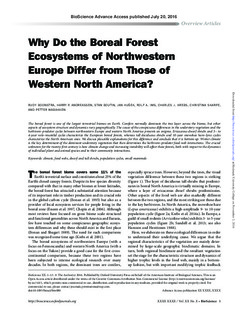Why Do the Boreal Forest Ecosystems of Northwestern Europe Differ from Those of Western North America?
Boonstra, Rudy; Andreassen, Harry Peter; Boutin, Stan; Husek, Jan; Ims, Rolf A.; Krebs, Charles J.; Skarpe, Christina; Wabakken, Petter
Journal article, Peer reviewed
Permanent lenke
http://hdl.handle.net/11250/2418940Utgivelsesdato
2016Metadata
Vis full innførselSamlinger
Originalversjon
Boonstra, R., Andreassen, H. P., Boutin, S., Husek, J., Ims, R. A., Krebs, C. J., . . . Wabakken, P. (2016). Why do the boreal forest ecosystems of Northwestern Europe differ from those of Western North America? Bioscience, 66(9), 722-734. doi: 10.1093/biosci/biw080 10.1093/biosci/biw080Sammendrag
The boreal forest is one of the largest terrestrial biomes on Earth. Conifers normally dominate the tree layer across the biome, but other aspects of ecosystem structure and dynamics vary geographically. The cause of the conspicuous differences in the understory vegetation and the herbivore–predator cycles between northwestern Europe and western North America presents an enigma. Ericaceous dwarf shrubs and 3– to 4-year vole–mustelid cycles characterize the European boreal forests, whereas tall deciduous shrubs and 10-year snowshoe hare–lynx cycles characterize the North American ones. We discuss plausible explanations for this difference and conclude that it is bottom-up: Winter climate is the key determinant of the dominant understory vegetation that then determines the herbivore–predator food-web interactions. The crucial unknown for the twenty-first century is how climate change and increasing instability will affect these forests, both with respect to the dynamics of individual plant and animal species and to their community interactions.
